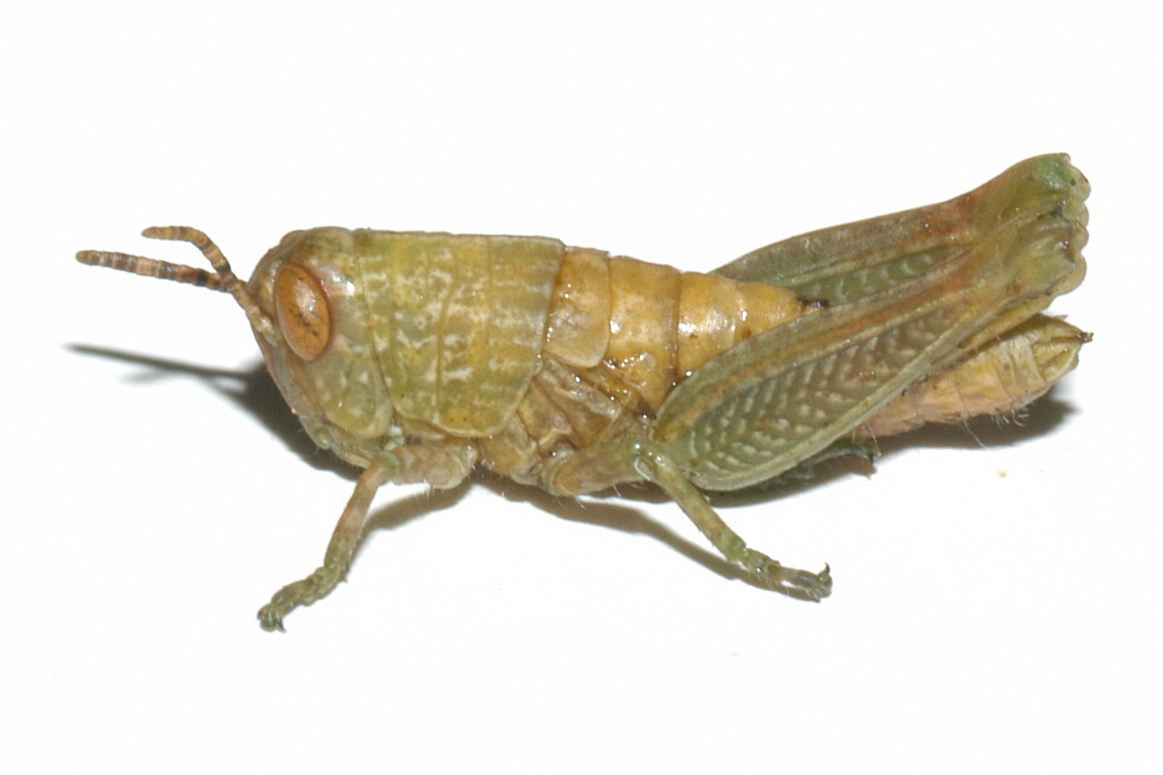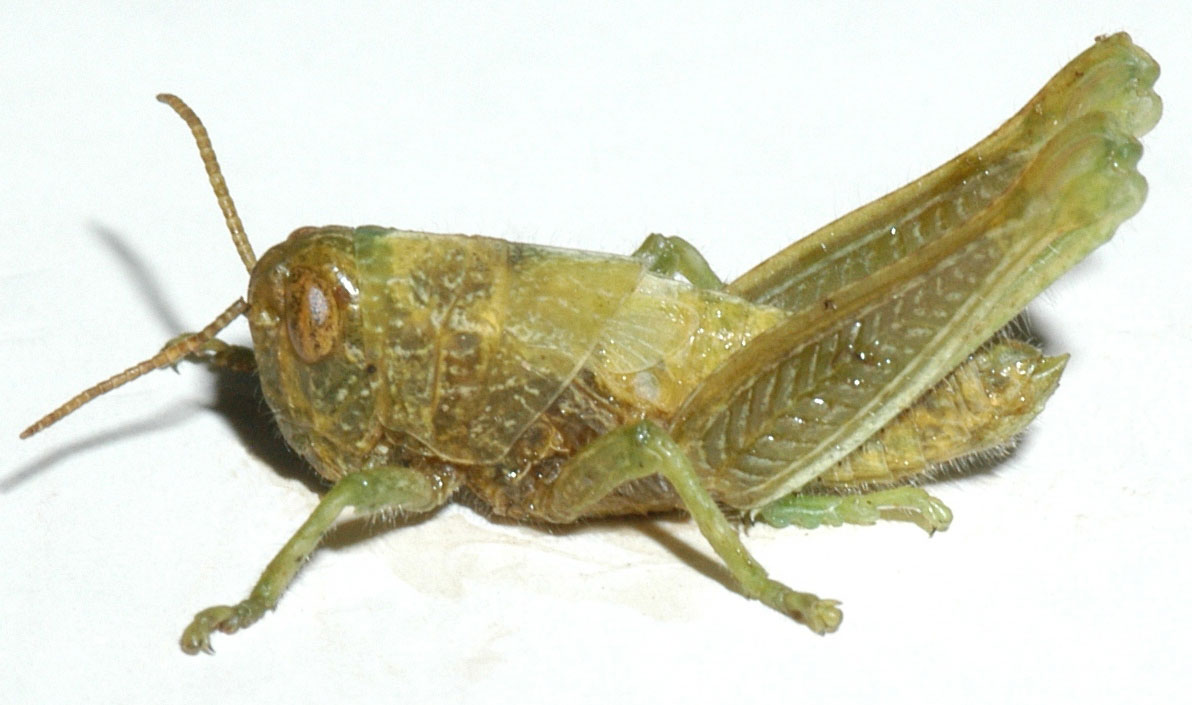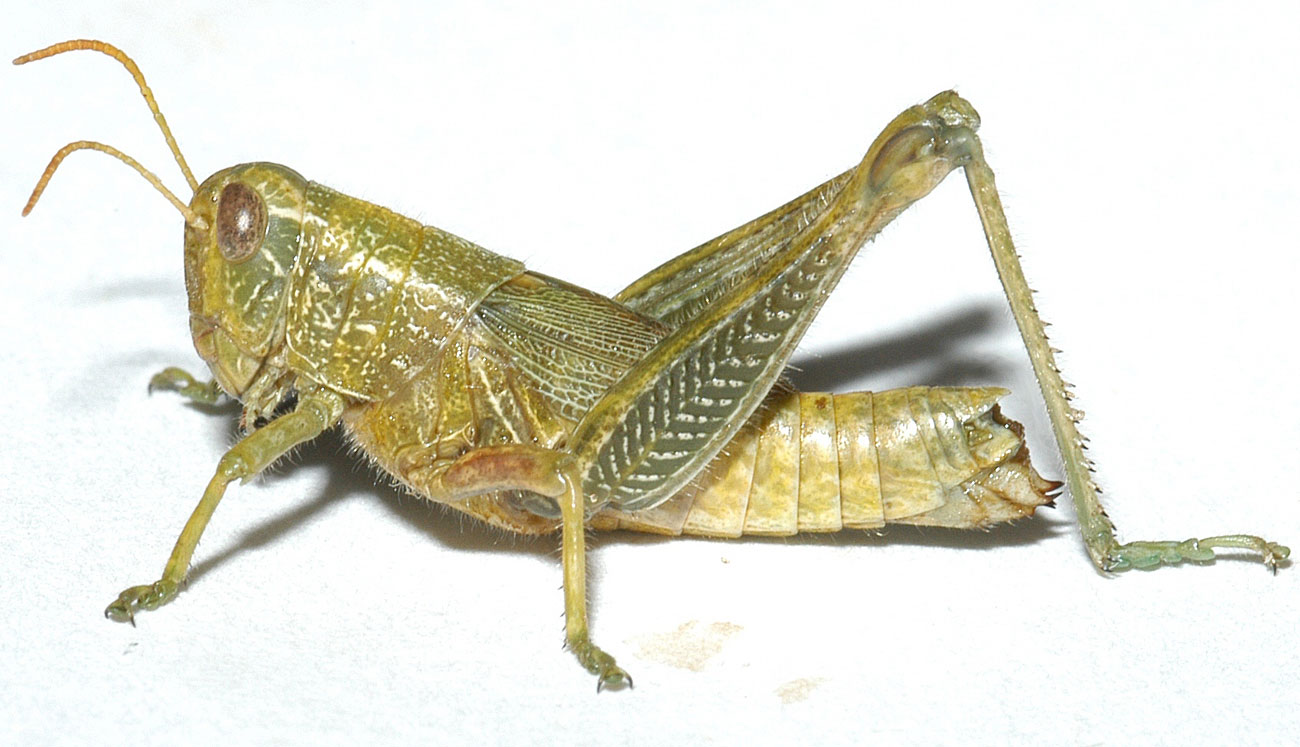Campylacantha olivacea
|
Geographic range of Campylacantha olivacea (Scudder) |
|
Fig. 1, second instar |
|
Fig. 2, third instar |
|
Fig. 3, fifth instar |
|
Fig. 4, adult male: BL 16-21 mm, FL 10-12 mm, AS 23-25 |
|
Fig. 5, adult female: BL 22-28 mm, FL 13-16 mm, AS 23-25 |
Species
Fuzzy olive-green grasshopper
Campylacantha olivacea (Scudder)
Subfamily Melanoplinae
Identification
Campylacantha olivacea is generally somewhat uniform in color, varying from green, to rarely brown or blackish. Typically it is virtually entirely olive-green in color. There are whitish markings in the form of tiny broken lines on the pronotum and parts of the head. Some of these lines usually coalesce to form a nearly continuous line extending part of the length of the pronotum from behind the eye toward the posterior. This white line is nearly contiguous with another in front of the hind leg. The eyes and antennae are brownish to reddish. The wings only rarely extend more than half the length of the abdomen. It might be confused with Hypochlora alba but differs from it in being a stronger green in color, more robust, and with distinct tiny light markings. The hind femur is greenish on both the inner and outer surfaces. The hind tibia is greenish to pallid greenish yellow.
Distribution and habitat
The fuzzy olive-green grasshopper occurs from Georgia and Illinois west to Nebraska, Colorado, Texas, and New Mexico. This grasshopper occurs in wide variety of habitats, and may be common in rangeland from short-grass to tallgrass habitats, as well as in partially shaded environments. In virtually all cases, it will be found in association with an abundance of weedy fords such as ragweeds. It is seldom abundant but can be relatively common in ragweed infested areas.
Economic importance
Because this grasshopper prefers weedy forbs such as ragweed, it might be considered beneficial rather than potentially destructive. It has been recorded to feed on grasses, but only in trace amounts.
Food preferences
Six grasses and seven forb species were found in crop analyses on this grasshopper. Fords found in these analyses included Ambrosia psilostachya, Amorpha fruticosa, Artemesia ludoviciana, Aster ericoides, Ceonothus ovatus, Reullia cilliosa, Solidago missouriensis, and Vernonia baldwini. Grasses are not the preferred hosts and it shows a distinct preference for Ambrosia (ragweeds). It has also been recorded as preferring Flourensia cernua (tar bush). Observations in Nebraska show a distinct association with ragweed, but feeding has not been directly observed.
Dispersal and migration
Little is known about the dispersal of this grasshopper. Nearly all adults have short wings, and long-winged forms are rare. Long-winged individuals may be able to disperse short to moderate distances, but most dispersal is probably between plants or among patches of preferred host plants.
Hatching
Little is known about the development of this grasshopper, but as adults occur late in the season, nymphs are likely in the late-hatching group.
Nymphal development
Nymphs are believed to develop through five instars. Nymphs are most commonly found in June and July in Nebraska.
Adults and reproduction
Adults remain in habitats occupied by the nymphs. Little is known about the reproduction of this grasshopper, but oviposition likely occurs relatively near suitable host plants. In Nebraska, adults begin to appear in early and middle August, become most numerous in late August and September, and may linger into October.
Population ecology
The population ecology of Campylacantha olivacea has not been studied but observations suggest that this grasshopper maintains relatively stable populations, potentially dependent on the availability of host plants. In areas infested with ragweed, it might periodically become numerous.
Daily activity
Little is known about the daily activity of this grasshopper.
Source and date
University of Nebraska by Mathew L. Brust March 2007
Selected references
Blatchley, W. S. 1920. Orthoptera of Northeastern America, with especial reference to the faunas of Indiana and Florida. The Nature Publishing Company, Indianapolis, Indiana. 784 pp.
Hebard, M. 1925. The Orthoptera of South Dakota. Proceedings of the Academy of Natural Sciences, Philadelphia 77: 35-155.
Hebard, M. 1929. The Orthoptera of Colorado. Proceedings of the Academy of Natural Sciences, Philadelphia 81: 303-425.
Helfer, J. R. 1987. How to Know the Grasshoppers, Crickets, Cockroaches and Their Allies. Dover Publications Inc. New York, New York. 363 pp.
McDaniel, B. 1987. Grasshoppers of South Dakota. South Dakota Agriculture Experiment Station Publication TB 89. 163 pp.
Mulkern, G. B., K. P. Pruess, H. Knutson, A. F. Hagen, J. B. Campbell, and J. D. Lambley. 1969. Food habits and preferences of grassland grasshoppers of the north central Great Plains. North Dakota State University Agricultural Experiment Station, North Central Regional Publication no. 196. 32 pp.





